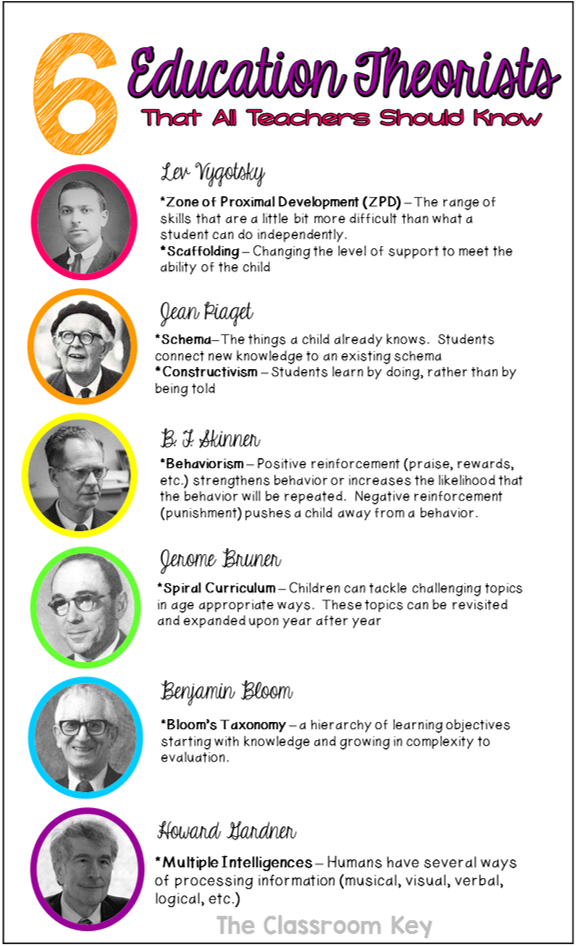As discussed in the last class about different Theories of Knowledge, Understanding learning theories can result in a variety of outcomes, from improving communication between students and teachers to determining what students learn. There are five primary educational learning theories: behaviorism, cognitive, constructivism, humanism, and connectivism.
“Learning is defined as a process that brings together personal and environmental experiences and influences for acquiring, enriching or modifying one’s knowledge, skills, values, attitudes, behavior, and worldviews,” notes the International Bureau of Education. “Learning theories develop hypotheses that describe how this process takes place.”
According to Roggeman, the effects of applied educational theory can be long-lasting.
She explains:
“The learning theories we experienced as a student influence the type of work environment we prefer as adults. For example, if one experienced classrooms based heavily on social learning during the K-12 years, as an adult, one may be very comfortable in a highly collaborative work environment. Reflection on one’s own educational history might serve as an insightful tool as to one’s own fulfillment in the workplace as an adult.”

I have always been a preschool teacher and Early childhood education is for children from the years three to six. In this field, we can get to know the importance of early childhood education to families as well as society by studying the objectives that early programs have meant for a child. First of all, information is consisting of fact concepts, ideas, vocabulary, and services in a small period of time plus disposition can respond to certain situations and after all feelings, and emotional states as successful caregiving and early education, can bring an optimistic outcome to a kid’s life. What a kid learns in their initial years are things that will remain to help them along in their upcoming in school and in the real world. On the other hand, cognitive development is the progression of the ability to think and reason. By contrasting the theories of Jean Piaget and Lev Vygotsky in the field of cognitive development and by examining the value of elements often found in the early childhood classroom peer interaction, pretend play, and computers, potentially valuable classroom practices will be examined especially in the context of technological advancement and socialization practices. Through the investigation of these elements, it will be determined whether a Piagetian or Vygotskian method will be further beneficial in the initial classroom. By understanding cognitive development, kindergarten educators will be able to better implement sound methodologies, providing a firm foundation for kindergarten children. (Cherry, 2014) explained that in view of Jean Piaget, kids grow within four stages of cognitive development. Each character is how kids understand the globe.
It is clear that the significance of early care and education cannot be overstressed. Early childhood education is critical to the work with a solid foundation of abilities, competencies, attitudes, and behaviors that will ensure their success in a more technology-based and competitive future economic environment. In contrast, there remain several distinct theories of youth education and advancement, theories play vital roles in understanding how kids learn. A key point in Piaget’s cognitive development theory is that kids actively construct knowledge such as they assimilate new information with existing mental structures or accommodate those mental structures to fit new information. This process results in cognitive balance or equilibrium. The principles of Vygotsky’s theory such as scaffolding in the zone of proximal development (ZPD) can be applied to all age groups. Anything the child acquires at a provided psychosocial stage of advancement is a certain ratio between the positive and negative, which if the balance is toward the positive, will help him to meet crises later in life, along with a better opportunity for unimpaired total development. Concisely, when both theories are used during combining together with one another, there is endless scope to help out kids develop critical thinking abilities and cognitive awareness for a well-rounded way to learn.
Thankyou 🙂
Thanks for sharing your thoughts Gunpreesh. I hadn’t made the connection between the learning theories we experienced firsthand as students and the subsequent influence it would have on our career choices. Reflecting on my own experiences as a student my teachers relied heavily on structures and procedures. I can see this now in my own teaching practice as I spend a great deal of time on organizational tasks. I wonder how my teaching style would have changed had I attended classes with more emphasis on student centered projects, or student driven assessment. This is not to say that I don’t utilize these tools, but instead that my personal preferences reflect the environments I experienced firsthand. It makes one think about how much unconscious bias we carry from own education into our daily teaching.